 Thicken
Thicken
![]()
![]()
![]()
Add depth to a surface. Create a new part or modify an existing one by giving thickness to a surface and converting it to a solid, adding or removing material from an existing part or surface, or intersecting parts in its path.
The Thicken feature allows you to add depth to a sketch, part face, or surface.
Click the Thicken feature on the Feature toolbar. Select a sketch, part face, or surface in the graphics area.
If a part face is selected, the Thicken type switches to Add, to add it to the existing part. You can change the type to New to create a New part, Remove, to remove from the existing part (note the Direction arrow is automatically flipped), or Intersect to keep only the intersection of the thickness values and the existing part.
Optionally, check Mid plane, then specify a thickness value of material to be added or removed in the Thickness field. The thickness of the material is symmetric relative to the selected face or surface.
Alternatively, keep Mid plane unchecked and enter a value in the Thickness 1 field in the dialog. Add a Thickness 2 value to thicken in the opposite direction.
Click the checkmark to accept the Thicken feature.
It is not uncommon to start a sketch using a surface and then thickening that surface. Select all the surfaces to thicken. Then select your thickness options. If you do not want to keep the surface, leave Keep tools unchecked. A new part is created out of the thickened surface. Note that solid bodies and sketches are never deleted. Check Keep tools to keep the original surface in addition to the new part.
Click the checkmark to accept the Thicken feature.
- Click the Thicken icon (
 ).
).
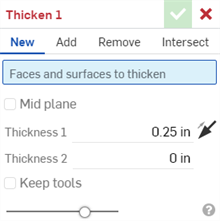
- Select whether to:
- New - Create a new solid
- Add - Add to an existing solid
- Remove - Subtract material from an existing part
- Intersect - Keep only intersecting materials
- Select the part face (or surface) in the graphics area.
- Either:
- Check Mid plane, then:
- Specify a thickness value of material to be added or removed in the Thickness field. The thickness of the material is symmetric relative to the selected face or surface.
- Leave Mid plane unchecked, then:
- Specify the value of material to be added or removed in the first direction (Thickness 1 field). Optionally, reverse the direction using the Opposite direction arrow icon (
 ).
). - Specify the value of material to be added or removed in the opposite direction to Thickness 1 in the Thickness 2 field.
- Specify the value of material to be added or removed in the first direction (Thickness 1 field). Optionally, reverse the direction using the Opposite direction arrow icon (
- Check Mid plane, then:
-
Optionally, check Keep tools to preserve the surfaces used by the Thicken tool. By default, when unchecked, the surfaces are deleted, and replaced by the newly created part. Solid bodies and/or sketches are never deleted,
- Optionally, specify a Merge Scope to indicate whether to incorporate the new material with all parts or a specific part, where appropriate.
-
Click the Checkmark icon (
 ).
).
When Mid plane is enabled, the value for Thickness is not the same as Thickness 1 or Thickness 2 when Mid plane is disabled. Values for these 3 fields are retained between enabling and disabling the Mid plane option.
New - Create new material that results in a new part:
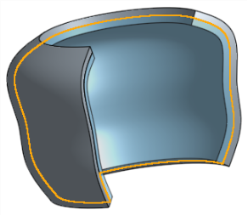
Add - Create material and add to the existing material:
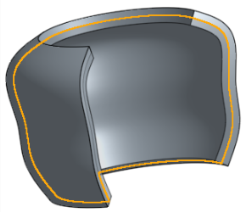
Take material away:
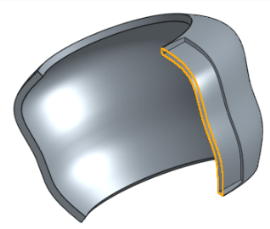
Leave material only where geometry overlaps:
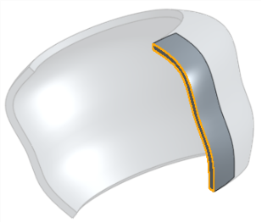
When adding material, you have the option to merge that material with other parts that touch or intersect its geometry:
- If the geometry touches or intersects with only one part then that part is automatically added to the merge scope.
- If multiple parts touch or intersect the geometry, then there is ambiguity and you must select which parts to merge with (the merge scope).
- A shortcut to selecting multiple touching or intersecting parts, you are able to check Merge with all to add all touching or intersecting parts to the merge scope.
If the Boolean is set to Add, Remove, or Intersect and nothing is set in the merge scope, the feature will result in an error. For New, no merge scope is available since New does not boolean the result.
This lists the collection of surface feature tools. This is not an exhaustive list. Additional Feature tools may be used when modeling surfaces. See Surfacing for additional information.
-
 Thicken - Add depth to a surface. Create a new part or modify an existing one by giving thickness to a surface and converting it to a solid, adding or removing material from an existing part or surface, or intersecting parts in its path.
Thicken - Add depth to a surface. Create a new part or modify an existing one by giving thickness to a surface and converting it to a solid, adding or removing material from an existing part or surface, or intersecting parts in its path. -
 Enclose - Create a part by selecting all boundaries surrounding an empty space to form a solid. Use any set of surfaces and solids (including planes and faces) that intersect each other or connect at a boundary to create a volume. Create a new part or modify an existing one by adding, removing, or intersecting parts.
Enclose - Create a part by selecting all boundaries surrounding an empty space to form a solid. Use any set of surfaces and solids (including planes and faces) that intersect each other or connect at a boundary to create a volume. Create a new part or modify an existing one by adding, removing, or intersecting parts. -
 Fillet - Round sharp interior and exterior edges and define as a standard constant radius, more stylized conic, or variable by selecting Edge fillet. Optionally apply a Full round fillet to create a seamless blend of one or more faces between two opposing sides.
Fillet - Round sharp interior and exterior edges and define as a standard constant radius, more stylized conic, or variable by selecting Edge fillet. Optionally apply a Full round fillet to create a seamless blend of one or more faces between two opposing sides. -
 Face blend - Round sharp connected or disconnected interior and exterior faces to create a seamless blend between the faces or detach the blend to create new faces, defining a radius or constant width. Further define the blend cross section (rolling ball or swept profile), symmetry, control, trim, constraints, and limits.
Face blend - Round sharp connected or disconnected interior and exterior faces to create a seamless blend between the faces or detach the blend to create new faces, defining a radius or constant width. Further define the blend cross section (rolling ball or swept profile), symmetry, control, trim, constraints, and limits. -
 Delete face - Remove geometry from a part. Select whether to heal the surrounding faces (by extending until they intersect), cap the void, or leave the void open. This Direct Editing tool is especially convenient if you don't have the parametric history of the part, as is often the case with an imported part.
Delete face - Remove geometry from a part. Select whether to heal the surrounding faces (by extending until they intersect), cap the void, or leave the void open. This Direct Editing tool is especially convenient if you don't have the parametric history of the part, as is often the case with an imported part. -
 Move face - Translate, rotate, or offset one or more selected faces. This Direct Editing tool is especially convenient if you don't have the parametric history of the part, as is often the case with an imported part.
Move face - Translate, rotate, or offset one or more selected faces. This Direct Editing tool is especially convenient if you don't have the parametric history of the part, as is often the case with an imported part. -
 Replace face - Trim a face or extend a face to a new surface. This Direct Editing tool is especially convenient if you don't have the parametric history of the part, as is often the case with an imported part.
Replace face - Trim a face or extend a face to a new surface. This Direct Editing tool is especially convenient if you don't have the parametric history of the part, as is often the case with an imported part. -
 Offset surface - Create a new surface by offsetting an existing face, surface, or sketch region. Set offset distance to 0 to create a copy in place.
Offset surface - Create a new surface by offsetting an existing face, surface, or sketch region. Set offset distance to 0 to create a copy in place. -
 Boundary surface - Create or add a surface specified by its boundary profiles.
Boundary surface - Create or add a surface specified by its boundary profiles. -
 Fill - Create a surface (or a part from surfaces) by defining boundaries and refine the surface with boundary conditions (instead of requiring the use of reference surfaces).
Fill - Create a surface (or a part from surfaces) by defining boundaries and refine the surface with boundary conditions (instead of requiring the use of reference surfaces). -
 Move boundary - Move boundary edges of a surface in order to extend or trim it.
Move boundary - Move boundary edges of a surface in order to extend or trim it. -
 Ruled surface - Create a new or additional ruled surface from an existing edge or multiple edges of a sketch region.
Ruled surface - Create a new or additional ruled surface from an existing edge or multiple edges of a sketch region. -
 Mutual trim - Trim two adjacent surfaces by extending intersections to complete the trim.
Mutual trim - Trim two adjacent surfaces by extending intersections to complete the trim. -
 Constrained surface - Create a surface from a selection of points or mesh data within a specified tolerance. Display deviations and optimize for performance or smoothness.
Constrained surface - Create a surface from a selection of points or mesh data within a specified tolerance. Display deviations and optimize for performance or smoothness.
Add depth to a surface. Create a new part or modify an existing one by giving thickness to a surface and converting it to a solid, adding or removing material from an existing part or surface, or intersecting parts in its path.
- Tap Thicken tool.
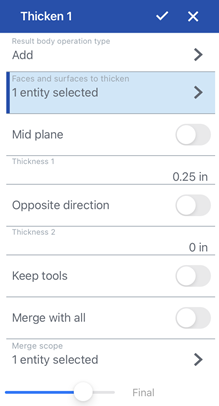
- Select a result body operation type:
- New - Create a new solid.
- Add - Add to an existing solid.
- Remove - Subtract material from an existing part.
- Intersect - Keep only intersecting materials.
- Select the part face (or surface) in the graphics area.
- Either:
- Toggle Mid plane on, then:
- Specify a thickness value of material to be added or removed in the Thickness field. The thickness of the material is symmetric relative to the selected face or surface.
- Leave Mid plane disabled, then:
- Specify the value of material to be added or removed in the first direction (Thickness 1 field). Optionally, reverse the direction using the Opposite direction toggle.
- Specify the value of material to be added or removed in the opposite direction to Thickness 1 in the Thickness 2 field.
- Toggle Mid plane on, then:
- If Mid plane is enabled, specify the thickness of material to be added or removed in the first direction (Thickness 1 field).
- Optionally, reverse the direction using the Opposite direction toggle.
- If Mid plane is disabled, specify the value of material to be added or removed in the opposite direction to Thickness 1 in the Thickness 2 field.
-
Optionally, use the Keep tools toggle to preserve the surfaces used by the Thicken tool. By default (not toggled on), the surfaces are deleted, and replaced by the newly created part. Solid bodies and/or sketches are never deleted,
- Optionally, specify a Merge scope to indicate whether to incorporate the new material with all parts or a specific part, where appropriate.
- Tap the checkmark.
When Mid plane is enabled, the value for Thickness is not the same as Thickness 1 or Thickness 2 when Mid plane is disabled. Values for these 3 fields are retained between enabling and disabling the Mid plane option.
New - Create new material that results in a new part
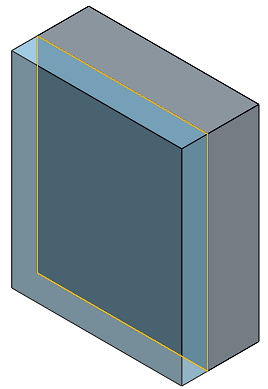
Add - Create material and add to the existing material
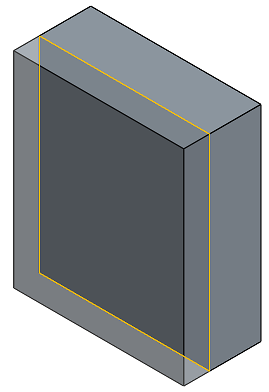
When adding material, you have the option to merge that material with other parts that touch or intersect its geometry:
- If the geometry touches or intersects with only one part then that part is automatically added to the merge scope.
- If multiple parts touch or intersect the geometry, then there is ambiguity and you must select which parts to merge with (the merge scope).
-
A shortcut to selecting multiple touching or intersecting parts, check Merge with all to add all touching or intersecting parts to the merge scope.
If the Boolean is set to Add, Remove, or Intersect and nothing is set in the merge scope, the feature will result in an error. For New, no merge scope is available since New does not boolean the result.
Remove - Take material away
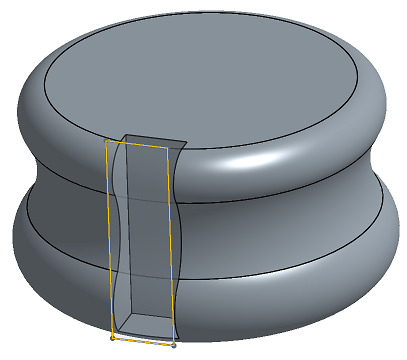
Intersect - Leave material only where intersections exist
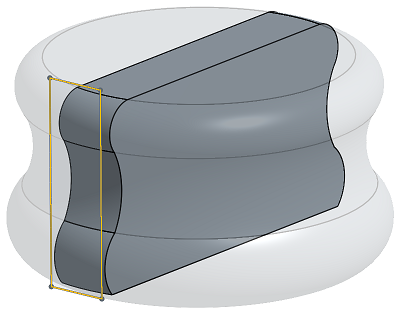
- Tap the Thicken tool icon (
 ).
).
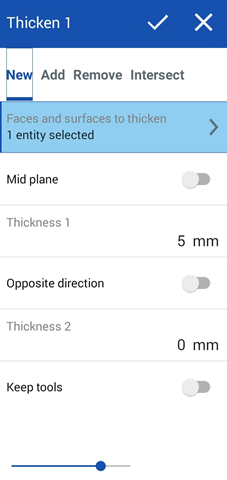
- Select a result body operation type:
- New - Create a new solid.
- Add - Add to an existing solid.
- Remove - Subtract material from an existing part.
- Intersect - Keep only intersecting materials.
- Select the part face (or surface) in the graphics area.
- Either:
- Toggle Mid plane on, then:
- Specify a thickness value of material to be added or removed in the Thickness field. The thickness of the material is symmetric relative to the selected face or surface.
- Leave Mid plane disabled, then:
- Specify the value of material to be added or removed in the first direction (Thickness 1 field). Optionally, reverse the direction using the Opposite direction toggle.
- Specify the value of material to be added or removed in the opposite direction to Thickness 1 in the Thickness 2 field.
- Toggle Mid plane on, then:
- If Mid plane is enabled, specify the thickness of material to be added or removed in the first direction (Thickness 1 field).
- Optionally, reverse the direction using the Opposite direction toggle.
- If Mid plane is disabled, specify the value of material to be added or removed in the opposite direction to Thickness 1 in the Thickness 2 field.
-
Optionally, use the Keep tools toggle to preserve the surfaces used by the Thicken tool. By default (not toggled on), the surfaces are deleted, and replaced by the newly created part. Solid bodies and/or sketches are never deleted,
- Optionally, specify a Merge scope to indicate whether to incorporate the new material with all parts or a specific part, where appropriate.
- Tap the checkmark.
When Mid plane is enabled, the value for Thickness is not the same as Thickness 1 or Thickness 2 when Mid plane is disabled. Values for these 3 fields are retained between enabling and disabling the Mid plane option.
New - Create new material that results in a new part

Add - Create material and add to the existing material

When adding material, you have the option to merge that material with other parts that touch or intersect its geometry:
- If the geometry touches or intersects with only one part then that part is automatically added to the merge scope.
- If multiple parts touch or intersect the geometry, then there is ambiguity and you must select which parts to merge with (the merge scope).
-
A shortcut to selecting multiple touching or intersecting parts, check Merge with all to add all touching or intersecting parts to the merge scope.
If the Boolean is set to Add, Remove, or Intersect and nothing is set in the merge scope, the feature will result in an error. For New, no merge scope is available since New does not boolean the result.
Remove - take material away

Intersect - Leave material only where intersections exist
